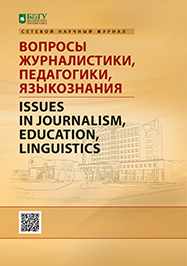Image-making content of a teacher’s personality in a modern educational space
DOI:
https://doi.org/10.18413/2712-7451-2020-39-2-227-237Keywords:
image of a teacher, structure of an image, functions of an imageAbstract
In the context of expanding international cooperation and an increase in the number of
participants in academic mobility programs, the level of foreign language training is of particular
importance. The purpose of this experimental study is to determine the content and structure of imagemaking
characteristics for future teachers of a foreign language. In this regard, the question arises about
the professionally, socially and personally effective teacher acting in the modern educational space. What
personal qualities are necessary for future teachers who will work in “schools of the future”? To achieve
the stated goal, we studied the concept of “image”; investigated the structure and functions of the image
of a foreign language teacher; conducted a survey among students of the department of “Pedagogical
Education”, the specialization “Foreign Languages”, as well as among pupils of the 9th and 10th grades
of schools in the city of Pskov and their parents in order to determine the components of the image of the
teacher that are important for them; on the basis of the theoretical and methodological base, we developed
guidelines for forming the image of a future teacher of a foreign language.
References
Атлас новых профессий. 2020. URL: http://atlas100.ru/ (дата обращения: 10.02.2020).
Психология управления. 1999. Л.К. Аверченко, Г.М. Залесов, Р.И. Мокшанцев, В.М. Николаенко. Отв. ред. М.В. Удальцов. М., Новосибирск, ИНФРА-М, 149 с.
Черепанова В.Н. 2006. Введение в педагогическую имиджелогию. Под ред. Макарени А.А., Самойловой М.И. 194 с.
Шепель В.М. 1994. Имиджелогия: секреты личного обаяния. Москва, Культура и спорт, Юнити, 320 c.
Амонашвили Ш.А. 2018. Основы гуманной педагогики. Книга 3. Школа жизни. М., Амрита-Русь, 320 с.
Василенко В.Н. 2008. Ноосферное сознание в поэтике поколений. К 145-летию В.И. Вернадского. Предисловие к монографии. В кн.: Дзюра А.И. Ноосферные предпосылки философии творчества. Вольные этюды. М., МАКС Пресс, с. 6.
Варданян М.Р. 2007. Имидж педагога как фактор здоровьесбережения субъектов образовательного процесса в основной школе. Автореф. дис. … канд. пед. наук. Омск, 23 c.
Донская Л.Ю. 2004. Психологические условия формирования имиджа учителя высшей школы. Автореф. дис. … канд. псих. наук. Ставрополь, 21 c.
Калюжный А.А. 2004. Психология формирования имиджа учителя. Москва, Владос, 224 c.
Кан-Калик В.А. 1987. Учителю о педагогическом общении. Москва, Просвещение, 190 c.
Капустина А.Н. 2004. Многофакторная личностная методика Р. Кеттелла. СПб., Речь, 104 с.
Каспржак А.Г. 2013. Институциональные тупики российской системы подготовки учителей. Вопросы образования, 4: 255–277.
Маркова А.К. 1993. Психология труда учителя. Москва, Просвещение, 192 c.
Пассов Е.И. 2001. Мастерство и личность учителя: на примере преподавания иностранного языка. Москва, Флинта, Наука, 240 c.
Почепцов Г.Г. 2001. Профессия: имиджмейкер. СПб., Алетейя, 256 c.
Симонова И.Ф. 2014. Формирование имиджа специалиста социально-культурной сферы в культурно-образовательном пространстве вуза. Дис. ... канд. пед. наук. Санкт-Петербург, 237 с.
Сомова С.В. 2015. Личность учителя иностранного языка. Современные проблемы науки и образования, 1 (2). URL: http://science-education.ru/ru/article/view?id=20192 (дата обращения: 25.02.2020).
Сонди Л. 2005. Учебник экспериментальной диагностики влечений. М., Когито-Центр, 557 c.
Фетискин Н.П., Козлов В.В., Мануйлов Г.М. 2009. Социально-психологическая диагностика развития личности и малых групп. М., Издательство Института Психотерапии, 362 c.
Шостром Э. 2008. Человек-манипулятор. Внутреннее путешествие от манипуляции к актуализации. Пер. Р. Римская, Н. Шевчук. М., Апрель-Пресс, 192 с.
Ямбург Е. 2007. Учитель – это стиль. Народное образование, 4: 175–179.
Bennet N. 1976. Teaching styles and pupil progress. Boston, Harvard University Press, 203 p.
Brown D. 2007. Principles of language learning and teaching. New York, Pearson-Longman, 347 p.
Campbell C., Kryszewska H. 1995. Towards teaching. Oxford, Heinemann, 86 p.
Eggen P., Kuachak D. 1996. Strategies for teachers. Teaching content and thinking skills. Boston, Allyn and Bacon, 346 p.
Evans C., Harkins M., Young F. 2008. Exploring teaching styles and cognitive styles: evidence from school teachers in Canada. North American Journal of Psychology: 567–582.
Grasha A. 1996. Teaching with style: a practical guide to enhancing learning by understanding teaching and learning styles. Pittsburgh, Alliance Publishers, 385 p.
Guangwei, H. U. 2004. Teaching and Learning a Second Language. A Guide to Recent Research and Its Applications. Asian Journal of English Language Teaching, 14: 151–156.
Heimlich J., Norland E. 1994. Teaching style: Where are we now? New directions for adult and continuing education, 93: 40–56.
Lightbown P., Spada N. 1999. How Languages are Learned. Oxford: Oxford University Press, 252 p.
Medgyes P. 1994. The non-native teachers. Bonn, Hueber, 114 p.
Puchta H., Rinvolucri M. 2005. Multiple intelligences in EFL exercises for secondary and adult students. Rome, Hebling languages, 158 p.
Abstract views: 472
Share
Published
How to Cite
Issue
Section
Copyright (c) 2020 Issues in Journalism, Education, Linguistics

This work is licensed under a Creative Commons Attribution 4.0 International License.


